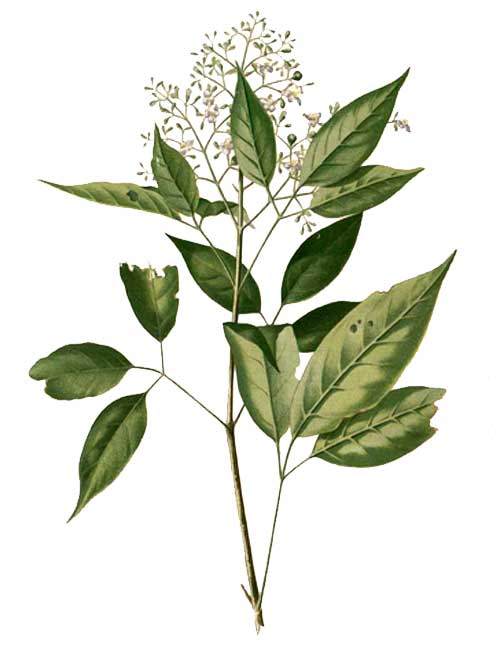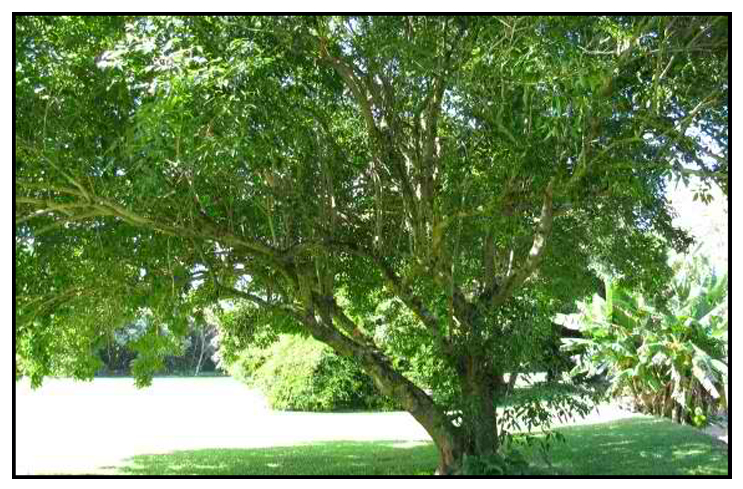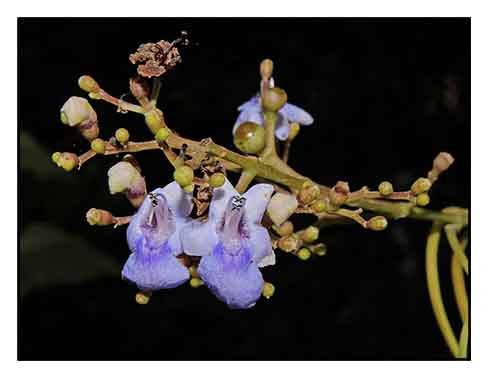 Gen info Gen info
- Vitex parviflora is a species of plant in the family Verbenaceae.
- The name "molave" is Spanish
, derived from 'mulawin', the Tagalog word for the tree.
- In the confusing landscape of commom names, "molave" is shared by Vitex parviflora (Mulawin, small-flower chaste tree) and Viitex pinnata (hairy-leafed molave). Both species are native to the Philippines.
Botany
Molave is a tree that reaches a height of 8 to 15 meters, smooth or nearly so, with inflorescences that may be slightly hairy. Leaflets are three, stalked, ovate to lanceolate, 7 to 18 centimeters long, pointed at the tip, shining and quite smooth. Flowers are blue, numerous, 6 to 8 millimeters long, hairy outside the corolla, borne on terminal, paniculate and ample inflorescences, up to 20 centimeters in length. Fruit is rounded, 5 to 6 millimeters in diameter.
 Distribution Distribution
- Native to the Philippines.
-
Common in secondary and open primary forests at low altitudes throughout the Philippines in most or all islands and provinces.
- Also native to Caroline Is., Lesser Sunda Is., Maluku, Sulawesi.
- Grows primarily in the wet tropical biome. (12)
- Listed as 'Vulnerable' in the IUCB Red List of Threatened Species.
Constituents
- Phytochemical studies have yielded flavonoids, triterpenoids, lignans and iridoids.
- Bark, root, and fruit all contain hydrocyanic acid and saponin.
- Phytochemical screening of
ethanolic extract of leaves yielded secondary metabolites, i.e., alkaloids, saponins, diterpenes, phenols, phytosterols, and flavonoids. (14)
- Proximate analysis of air-dried molave leaves yielded 16.95 ± 0.07% moisture, 9.37 ± 0.08 % ash, 1.80 ± 0.14 % crude fat,
33.18 ±0.49 % crude fiber, 16.94 ±2.69 % crude protein, and 21.76 ± 2.60 % carbohydrates. (14)
- Study of chloroform extract of dried leaves yielded a flavone, retusin. (see study below)
(17)
 Properties Properties
- Wood takes on a yellowish-green or greenish brown tint when boiled in water
-
Antimicrobial and antifungal properties have been reported.
- Considered carminative, anthelmintic, digestive.
- Studies have suggested antioxidant, larvicidal, antibacterial, wound healing, anti-inflammatory, anti-ulcer, antispasmodic, wound healing properties.
Parts used
Bark, leaves, stems, wood.
Uses
Folkloric
- Decoction or infusion of wood considered a remedy for poisons, as it induces vomiting.
- Decoction of bark used for diarrhea.
- Ayta people of Porac, Pampanga burn dried leaves and stems as repellent against hematophagous insects. (15)
-
Aytas of Dinalupihan, Bataan, use the peels, stems, and leaves for preparing baths during and after pregnancy. (18)
- In Southeast Asia, used for stomatitis, anorexia, blindness, leprosy, worm infestation, rheumatic swellings.
- In Kerala State of India, bark and wood decoction of Terminalia catappa and V altissima used for bathing women after childbirth.
- Bark and wood used as styptic, emetic, antitoxic, and to treat jaundice and dropsy. (10)
Others
- Wood: Known in the Philippines for its extremely hard wood with a density of 940 kg/m3 at 15% moisture, resistant to fungal, termite, and Lyctus beetle attack, but not to marine borers. Used like teak for shipbuilding and construction in contact with the ground. Also a source of firewood.
- Fish poison: Fruit and bark used as fish poison in the Philippines.
- Fodder: Leaves used as fodder.
- Shade/Shelter/Reclammation: Molave has been suggested for shelterbelts in the Philippines. Planted in reforestation projects. (10)
- Resin: Exudes a yellow resin when the wood is treated with lime. (10)
- Tannin / Dyestuff: Shavings soaked in water yields a yellow extract.
 Studies Studies
• Iridoid Glucosides / Antioxidant: Study yielded six new iridoid glucosides together with two known iridoids, agnuside and negundoside, from the ethyl acetate extractive of the leaves of V altissima. Compounds 2 - 4 showed potent antioxidant activity by free radical scavenging and DPPH radical scavenging methods. (1)
• Larvicidal: Study of methanol extracts of four Vitex species - V. negundo, V. trifolia, V. peduncularis and V. altissima, showed varying levels of larvicidal activity. The early fourth instar larvae of Culex quinquefasciatus was used for the larvicidal assay. (2)
• Antibacterial / Leaf and Stem: Study of leaf extract showed moderate activity against both Gram-negative and Gram-positive bacteria. (3) Study investigated the antibacterial activities of crude methanolic extracts of Vitex parviflora leaves and stem and Cyanthillium cinereum against human pathogens. Leaf and stem extracts of V. parviflora exhibited high antibacterial activity against Staphylococcus aureus. Increasing concentration of VP leaves showed increase anti-Staphylococcal activity as evidenced by increased diameters of zone of inhibition. (16)
• Wound Healing: Study was done on the wound healing property of ethanol leaf extracts of V. trifolia and V latissima. On comparison with control group. both leaf extracts were found to possess significant wound healing potency. (4)
• Anti-Inflammatory / Antioxidant / Phytochemicals: Study of ethyl acetate extracts of leaves of VA yielded a new tetrahydrofuranoid lignan, altissinone and a new acylated flavone C-glucoside. The extract exhibited significant anti-inflammatory activity in the rat paw edema model. The flavonoids and triterpene acids showed moderate antioxidant and 5-lipooxygenase inhibitory activities. (5)
• Anti-Inflammatory: Study of different leaf extracts of V. altissima was done on male albino rats to evaluate acute and subacute anti-inflammatory activity. Results showed significant anti-inflammatory activity with aqueous and alcoholic extracts and supports the tribal use of the plant for ailments of short duration. (6)
• Antimutagenic / Terpenes and Sterols: Study of ethyl acetate extract of leaves indicated the presence of phytol 1a, with lupeol 1b and ß-amyrin 1c as impurities, and sitosterol and stigmasterol. Micronucleus tests indicated reductions in the number of micronucleated polychromatic erythrocytes induced by Mitomycin C, indicating antimutagenic activity. (7)
• Antiulcer Healing: Study evaluated the extracts of three plants (bataw, molave, and alugbati) on albino mice with ethanol-induced ulcer. Results showed molave and alugbati with greater anti-ulcer activities than bataw. (News: Phil Star) (8)
• Antispasmodic / Bark: Study evaluated a crude bark extract for antidiarrheal effect of V. parviflora as alternative remedy for diarrhea in albino mice. (11)
• Antioxidant Potential / Total Phenolic and Flavonoid Content / Leaves: Study of air-dried leaves yielded a total phenolic content of 356 ± 19.4 mg gallic acid equivalent (GAE) per 100g air-dried leaves and total flavonoid content of 321.16 ± 16.71 mg quercetin equivalent (QE) per 100g air-dried leaves. Results suggest high antioxidant potential of extractable components from the leaves of molave. (see constituents above) (14)
• Flavone / Retusin / Antimicrobial / Dried Leaves: Study of chloroform extract of dried leaves yielded retusin. Antimicrobial testing of retusin indicated moderate activity against fungi, A. niger and low activity against bacteria, P. aeruginosa. It was inactive against fungi C. albicans and T. mentagrophytes and bacteria E. coli, S. aureus, and B. subtilis. (17)
• Antiproliferative / Human Prostate Cancer / Leaves: Prostate cancer is considered one of the most common non-skin cancer in the United States. In the Philippines, it is one of the top five cancers among men, occurring in 19.3 out of 100,000 male population. Study evaluated the effect of crude flavonoid extract from Molave against PC-3 cell line. MTT assay data showed the extract was able to elicit cytotoxic effect against PC-3 cells. Statistical analysis showed significant difference between untreated cells and extract concentratons of 250 and 500 mcg/mL for 24 hr incubation, indicating effectiveness in lovering the number of cancer cells. Results suggest the flavonoid extract from V. parviflora leaves had cytotoxic activity against PC-3 cell line. (19)
• Antibacterial / Streptococcus mutans / Leaves: Study evaluated and compared the antibacterial efficacy of 50 mg/ml and 100 mg/ml concentration of fresh molave leaves methanolic extract with 0.12% chlorhexidine, distilled water and 95% methanol on growth inhibition of S. mutans. The 100 mg/mg and 50 mg/ml concentration of leaves extract and chlorhexidine produced inhibition zones of 12.78, 11.63, and 21.44 mm, respectively. Vitex parviflora leaves extract showed growth inhibitory effects on S. mutans, but weaker compared to chlorhexidine. (20)
Availability
Wild-crafted.
|

![]()




 Distribution
Distribution Properties
Properties
